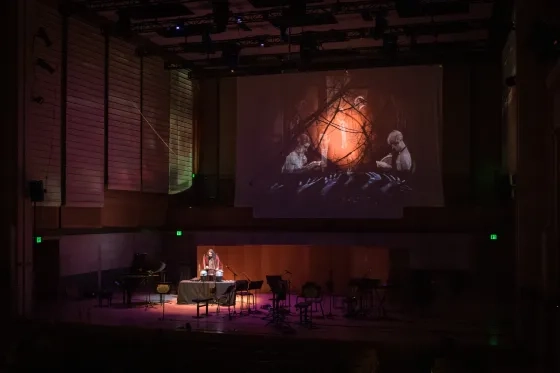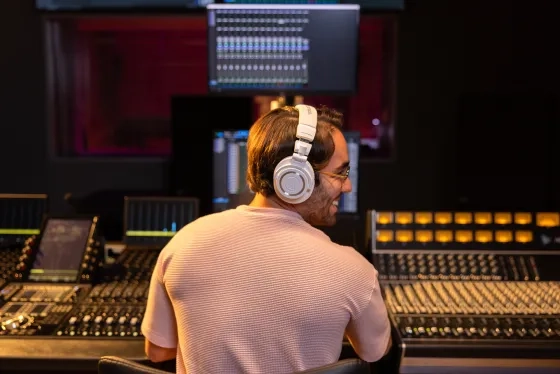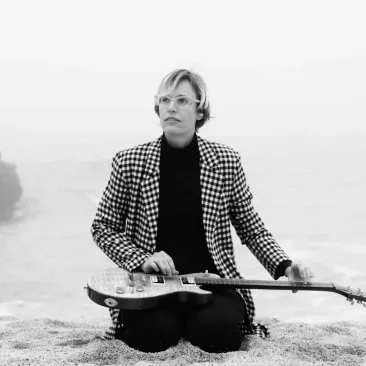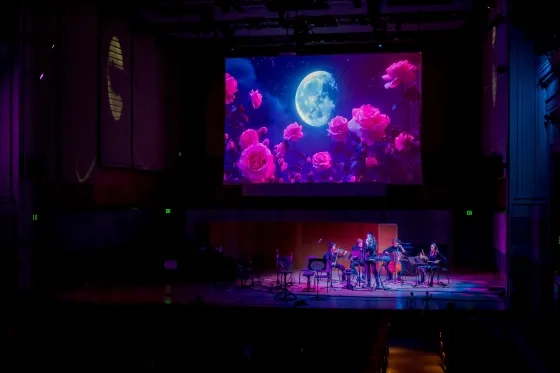Write It. Mix It. Stage It: How SFCM's Music Technology Program Creates New Artists
SFCM's Technology and Applied Composition program offers tracks designed for film and video game scoring, performing as a composer, and everything in between.
Multi-hyphenate performer JVNA's latest single, "Angels Falling," is being called an "enthralling hyperpop meets pop electronic envelopement," maybe not typically language associated with a music conservatory—but then again, SFCM isn't your typical conservatory.
SFCM is where JVNA got her training, and now the Conservatory is making it easier than ever for young musicians to follow in her footsteps.
The singer/songwriter, multi-instrumentalist, and creator graduated from SFCM's Technology and Applied Composition (TAC) Program in 2019. Since then, she's been touring as an electronic artist, releasing music and headlining iconic venues like the LA's Fonda Theatre and New York City's Webster Hall.
"Art is a free form," JVNA said of her time at the Conservatory, crediting the program for "being very open and receptive to students' personal creativities and not letting the strictness of classical music define the curriculum."
The TAC program integrates traditional composition with music technology to develop a new generation of composers adept in the fields of concert music, sound design, and film and video game scoring. This year the department added additional optional tracks for those interested in film scoring, video game scoring, and the emerging area of composer-performer.
"With the composer-performer track, students gain the skills needed to create their own unique work and share it with others on stage and across various media," said TAC faculty Barbara Nerness. "In many other situations, you are composing for someone else, but where do you begin when it's just for you?" she added. In addition to teaching, Nerness is an artist, composer, and part of the PhD program at Stanford University's Center for Computer Research in Music and Acoustics (CCRMA), where her research combines the scientific and creative aspects of performance.
Every student in the TAC program learns how to create, multitrack, record, overdub, edit, and mix music in a variety of styles using sophisticated digital audio systems, opening up careers in audio engineering, sound design, film and game scoring. The composer-performer track is set apart by how it adds live spatial audio, lighting, and visual media to the skill set of students who envision their musical life organized around live performance. "This is for musicians who are focused more on areas including songwriting, electronic music, synthesis, album work, and being a performing songwriter, experimental artist, and music producer," Lennie Moore, a longtime professor in the TAC program and accomplished game composer, said.
"There's all this technology out there that is very much available and important to teach," SFCM Studio Manager and TAC faculty Doug McCausland said, adding, "We're training people not just to use music technology, but how to build that knowledge into a complete experience based around a live performance."
Recent productions by SFCM's TAC program explore the intersection of music, visuals, and technology, including TAC's The Future is Female concert, as well as a Halloween concert that projected stunning visuals across SFCM's largest concert hall to accompany music created by students.
For emerging artists, Nerness advises that while some technology can seem "mystifying," at first, the field is only growing larger. "Most composer-performers today are juggling a variety of skill sets and tools for audio and video production."
Nerness adds that while the hum of a computer may not invite listeners on a musical journey, mastering that technology can lead to staging the career of your dreams. "There is an art to being able to hide the complexity of the technologies you use in order to create and direct an unforgettable experience."
Learn more about Technology and Applied Composition.




